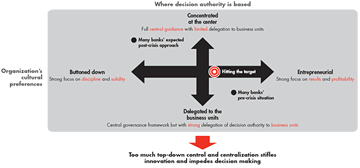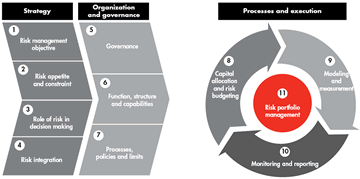Article
Striking the right balance in risk-management and capital-allocation decisions.
The collapse of global credit markets exposed profound flaws in banks' management of risk and capital, papered over by soaring growth.
By now, the problem is fairly well known. With investors hungry for higher returns and short-term growth, bankers rushed to oblige, placing their trust in "black box" models to control risk as they worked to boost earnings. They created exotic new products and added debt that moved them rapidly up the risk curve. Incentives helped fuel the excess, rewarding managers for hitting short-term performance goals that encouraged excessive risk taking. Meanwhile, the risk-control tools they relied on to guard against dangerous exposure provided a false sense of security. Banks thought they had sound risk control mechanisms in place, when in fact they only had pieces with no end-to-end decision-making processes.
As a result, prudent banking turned upside down: pressure to book earnings gains on the profit-and-loss statement superseded the liquidity and stability of the balance sheet. The consequences have been painful.
The risks of over-reaction
Yet the next phase also holds a real danger-overcorrection. While many are tempted to rein in the bankers, a no-growth banking industry is in no one's interest. A banking industry that embraces controlled risk-taking is vital to the world economy. Yet as banks reassert control, the pendulum is swinging back to centralized decision making, rigid risk aversion, and overly cautious capital allocation. (See figure 1.) Proposed regulatory reforms and internal pressures for tougher oversight have started to push banks hard in that direction. Bankers aiming to curb entrepreneurial excess may suffocate innovation and stifle growth.
A new approach to balancing risk
Restoring rigor and balance to risk management and capital allocation requires tackling the problem at its source: by establishing clear, effective decision processes to weigh risk and deploy capital according to the bank's strategic objectives and longer-term efforts to increase shareholder value. Those disciplines are the heart of an approach we call Risk- and Capital-Adjusted Decision-Making, or RaCADTM, which anchors risk and capital management in the organization's strategy, governance, and operating rhythms. (See figure 2.)
RaCAD's objectives are easy to understand but difficult to achieve. Here's how some leading global banks are implementing it:
Organizations adopting RaCAD begin by articulating the firm's overarching risk and capital strategy. That strategy provides business-unit leaders with explicit guidance in four areas:
- RaCAD makes clear the institution's risk appetite and spells out the constraints that curb it;
- It defines line managers' objectives for managing risk, capital and liquidity;
- It sets guidelines for how risk and capital should figure in line managers' decision making consistent with the bank's overall risk appetite;
- It determines what types and sources of risk the bank should consider taking on, and ensures this analysis underpins key decisions.
Figure 1: In fixing the problem, banks are apt to overcorrect
View the larger version of this chart
Figure 2: The elements of integrated Risk- and Capital-Adjusted Decision Making (RaCAD)TM
View the larger version of this chart
Clear governance rules reinforce the bank's risk and capital allocation strategy and guide its execution.
- RaCAD defines roles and functions for risk and capital management, and it determines how they should support decisions by line managers;
- It prescribes a coordinated structure of functions, committees, and line responsibilities that ensure good decision making with appropriate oversight and minimal bureaucracy;
- It assigns consultation roles to ensure that decision making is efficient, comprehensive and timely across risk types, products and lines of business.
Finally, the framework aligns strategy and governance in the day-to-day decisions made by banks' operating units:
- RaCAD provides line managers with clear, consistent procedures for allocating and budgeting capital consistent with the levels of risk set for their business units;
- It provides tools for monitoring and reporting the unit's capital and risk position;
- It provides line managers with clear procedures for allocating and budgeting capital and risk, consistent with the appetite and constraints set for their business units.
By achieving a better balance between risk and return, and providing a mechanism for control across the entire group, RaCAD becomes a source of competitive advantage. Flexible and adaptable, it provides a holistic approach for managing risk across the organization, while leaving division managers room to run their businesses. It breaks down organizational silos and speeds up response time. Finally, by making the bank's appetite for risk transparent both at the strategic and operating level within the organization, RaCAD defines the bank's risk profile more quickly and accurately to the external market. That yields two powerful benefits: attracting new investors and customers and positioning banks to compete more effectively against struggling rivals.
For discussion:
- Do you know where and why risk management and capital allocation processes broke down within your bank?
- Are you clear on what you need to do to repair them in ways that are both rigorous and sustainable?
- Do your line managers understand the implications of an integrated risk management and capital allocation system on how they run their businesses?
Key contacts in Bain's Global Financial Services practice:
Europe: Paolo Bordogna, Mike Baxter and Rocco D'Acunto
Americas: Andrew Schwedel and Alan Colberg
Asia-Pacific: Gary Turner and Sunny Yi
